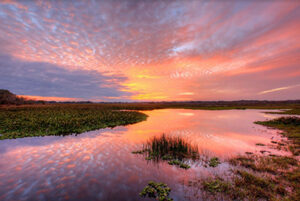 October of 2021 — Back in 1999, when Rob and I were seeking a building permit for our backyard office building where Rob about five years later will discover DiTetra Gas used to make Watt-Ahh polarized water, Sarasota County, FL. authorities required an archaeological dig. What was discovered was evidence of a hunting camp of unknown people that pre-dated the Seminole Indians. The evidence were several small shards of stone that the archaeologist shifted out of the Myakka white sand. The stone had been heated and chipped to likely create sharper edges used in cutting. The Myakka sand* comes from the ancient sand dunes when the ocean covered the central ridge of the Florida peninsula. The archaeologist told us that finding chipped stones in the sand is evidence of human activities. The unknown people must have either traveled over 50 miles north to the closest rock quarry what is now Tampa, FL. or had the sophistication to trade for the stone. The acidic nature of the Myakka sand had dissolved all evidence of human skeletal remains over the centuries, long before the birth of Christ. These unknown hunters and gatherers are part of the heritage of a great natural river, the Myakka River where we built our office building along the edge of its floodplain (the distance to the banks of the river itself is about a mile away).
October of 2021 — Back in 1999, when Rob and I were seeking a building permit for our backyard office building where Rob about five years later will discover DiTetra Gas used to make Watt-Ahh polarized water, Sarasota County, FL. authorities required an archaeological dig. What was discovered was evidence of a hunting camp of unknown people that pre-dated the Seminole Indians. The evidence were several small shards of stone that the archaeologist shifted out of the Myakka white sand. The stone had been heated and chipped to likely create sharper edges used in cutting. The Myakka sand* comes from the ancient sand dunes when the ocean covered the central ridge of the Florida peninsula. The archaeologist told us that finding chipped stones in the sand is evidence of human activities. The unknown people must have either traveled over 50 miles north to the closest rock quarry what is now Tampa, FL. or had the sophistication to trade for the stone. The acidic nature of the Myakka sand had dissolved all evidence of human skeletal remains over the centuries, long before the birth of Christ. These unknown hunters and gatherers are part of the heritage of a great natural river, the Myakka River where we built our office building along the edge of its floodplain (the distance to the banks of the river itself is about a mile away).
Since the unknown tribe had no written language, the origin of the name “Myakka” also remains a mystery to the historians. The Crowley Museum and Nature Center** offers this article in trying to unravel the naming mystery of Myakka.
There are relatively few native freshwater lakes in Southern Florida. The Myakka River flows into two, called the Upper and Lower Lakes and today are part of the Myakka River State Park. The largest freshwater lake in Florida is Lake Okeechobee, about 90 miles southeast of the Myakka lakes. The oldest known name for Lake Okeechobee was “Mayaimi”, meaning big water.
A surveyor in the 1840’s encountered a group of Seminoles who told him the river was called the “Miarca”. The first map subsequently showed the spelling of Myakka but kept the ancient name of the its headwaters “Locha notia” or sleeping turtles. Another name spelled Miakka would show up on subsequent maps and that spelling was ultimately adopted by a settlement located near today’s Crowley Museum.
The names of Mayaimi and Miarca certainly meant “big waters” for those ancient hunters seeking sustainability in a vast wilderness. Living near a “big water” that is protected with its hidden history has been a privilege for me over 34 years. It seems universally fitting that Watt-Ahh was discovered here with all of its molecular mysteries. Maybe it is meant to be that we will not totally understand the mysteries of “big waters” but our roles are to protect them for future generations.

* Myakka is a native soil of Florida and does not occur in any other state. It was designated the Florida State soil, supporting native habitats of pine flatwoods, oak hammocks and rare scrub oak areas as well as used in citrus agriculture, a major State industry.
** The Crowley Museum and Nature Center has living exhibits of Florida’s pioneering life. The Museum is located north of the AquaNew office and it also protects the native habitats of the Myakka River floodplain.
